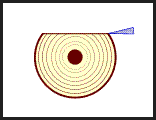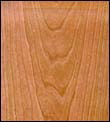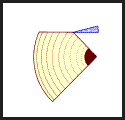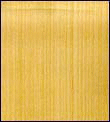|
GRAIN PATTERNS
The grain
structure of different species of wood vary tremendously and as
a naturally grown product they vary from within their own specie
from tree to tree. Being able though to bring about some
predictability to this structure has obvious advantages. This
can be achieved by slicing in a variety of ways.
|
 |
1/. Flat-Cut /
Flat-Sliced / Plain-Sliced
This is probably
the most common form of veneer slicing performed on decorative
hardwoods. As shown in the picture left. The slicer presses
through the log on a plane tangential to these growth rings. The
result is a roughly symmetrical central grain pattern that is
characterised by a "catherdreling" of the grain and also
ellipses and ovals. This form of slicing undoubtedly produces
the most attractive and regular form of "crown" veneer.
|
|
As the slicer approaches the centre of the
log i.e. its core (shown dark in the illustration), it will
start to become defective. At this stage it is usually necessary
to trim out this defective centre, leaving straight grain or
half-grain or half-crown veneer, largely free from the
cathedrals, ellipses and ovals mentioned earlier. Once through
the core normal slicing can resume. It is for this reason that
the flat-cut logs are often deemed to have two sides. |
 |
 |
2/. Quarter-Cut
Often it is
desirable to maximise the yield of straight grained material
from a log i.e. that free of cathedrals, ellipses and ovals.
This is especially the case when people are trying to achieve
continuity throughout a range of veneer products. Some species
also do not lend themselves to being flat-cut, either due to
their crown wood being unattractive or the texture of the wood
making it difficult to produce.
|
|
The logs are
firstly cut into quarters. The log is then sliced on a plane
that is tangential to the growth rings and on the 45% line from
the centre of the log. The result is highly regular quarter-cut
or straight grained veneer.
|
 |
 |
3/. Half-Round
This is a
variation of the flat-cut method of slicing veneer. It is
produced on a face lathe by rotating the log around an
off-centre axis in an arc. This method results in almost the
whole of the log yielding a crown feature. it also, by
increasing the plane of the cut, increases the width of veneer
produced, hence making it a useful technique when processing
narrow logs. Because of the off-set axis of the log the crown is
often not as central as that produced from the flat-cut logs.
Also the crown effect is much "wilder" (i.e. catherdraling, etc,
is not as pronounced) than that produced under the flat-cut
method. The greater the circumference of the log then generally
the more wilder the grain becomes.
|
|
4/. Rotary-Cut
This is when a log
is rotated about its central axis and peeled from the outside.
The grain pattern that is produced is a large swirl'y pattern of
irregular shapes. This method is rarely used on decorative
hardwoods, it is usually employed to maximise yields from cheap
woods used to produce veneer for plywoods.
|
 |
|
Thanks once again to
Duncan Richards for allowing us to use the above page from
his web site.
D. F. RICHARDS
(VENEERS LIMITED) has a very friendly and informative web site
that we can fully recommend you to visit - just click the link
on our "useful links" page (button below) to take you to the
site
|
| |


